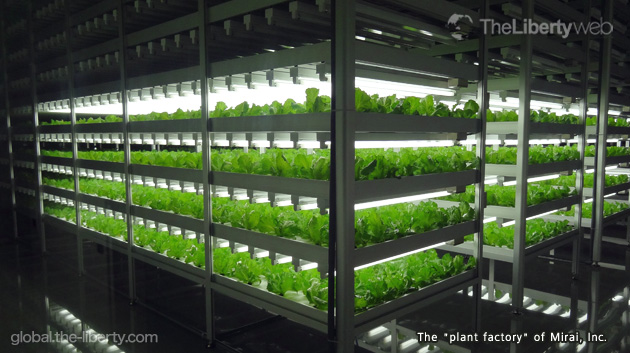I Will Feed 10 Billion People!
Export plant factories to the world.

Mirai, Inc. CEO Shigeharu Shimamura,
graduated from Tokyo University of Agriculture, Faculty of Agriculture, Department of Forestry in 1996.
After completing the first half of a doctoral course in the Graduate School of Natural Science Research at Chiba University in 1999, he tackled the development of a plant factory. He established “Mirai, Inc.” in 2004.
“In the world today, there are nearly 1 billion hungry people. If the population of the world continues to increase toward 10 billion, the world will inevitably face a food crisis.”, says Shigeharu Shimamura, CEO of Mirai Inc., who leads the cutting-edge technology as a researcher of a “plant factory.”
What kind of challenges is agriculture now facing, when we are going to see 10 billion people in the 21st century? “Chemical fertilizers developed in the 20th century increased productivity by leaps and bounds, and it seemed that we could overcome the food crisis. However, production has hit the ceiling. It is due to lack of sufficient water”. Shimamura says that water for agricultural use is running short all over the world. A plant cannot absorb any fertilizer that is not dissolved in water.
“If the land is watered, 97 to 98% of the total volume will not be absorbed by roots of plants and will sink into the ground or evaporate. This is the largest bottleneck of the present agriculture. Moreover, the present agricultural technology cannot sufficiently cope with unexpected climate changes.”
“Even if the present economical gaps are leveled, an estimated 2.5 billion people will suffer from hunger when the world population increases to 10 billion. 50 years ago, there were only 2.5 billion people living in the world. Now, the population has tripled. I believe that the new era needs a new agricultural technology.”
The “plant factory” can solve the difficult problem of water shortage.

Plant factories can grow crops anywhere. They were introduced in the Showa Station in the Antarctic two years ago.
The “plant factory”, which artificially makes an environment suitable for growing plants using artificial light, has attracted the attention of those concerned with finding a method for overcoming the food crisis.
“I tackled the plant factory because vegetables and plants are at the very “base” of the food supply. It is plants that occupy most of cultivated acreage. Plants need water and labor to grow. They are also hard to preserve. The plant factory can undertake these difficult factors to control in agriculture and we can increase the production of grains in the vacant arable land. That is the idea.”
So what kind of merit does the plant factory have? “We can only harvest a certain amount from an area of a farmland fundamentally. But in the case of the plant factory, one floor can produce up to 50 times of farmland production by controlling growing speeds of the plants and by piling up stages utilizing space. We can produce 500 times more if it is a factory of 10 stories. The products are safe, as agricultural chemicals are not used and there is no damage caused by continuous cropping.”
As the factory is a closed space, water usage can be greatly and effectively improved. “Usually only 2 to 3% of water used is absorbed by plants. But here, more than 80% of water is actually absorbed. Water shortage, which is the largest bottleneck, can be solved.”
“Reproducibility is the best point in a plant factory. We can produce similar products anytime, anywhere. A plant factory has been operated for the past two years at Showa Station in the Antarctic. It is a technology which can also be practiced in a space station or a submarine environment. Moreover, although the taste and nutritive values vary with the seasons in garden farming, the products produced in a plant factory are stable in the quality.”
Satellites are now used for estimating a harvest index. But in a plant factory, we can control what and how much to produce. The plant factory products are just like “industrial products”.



















